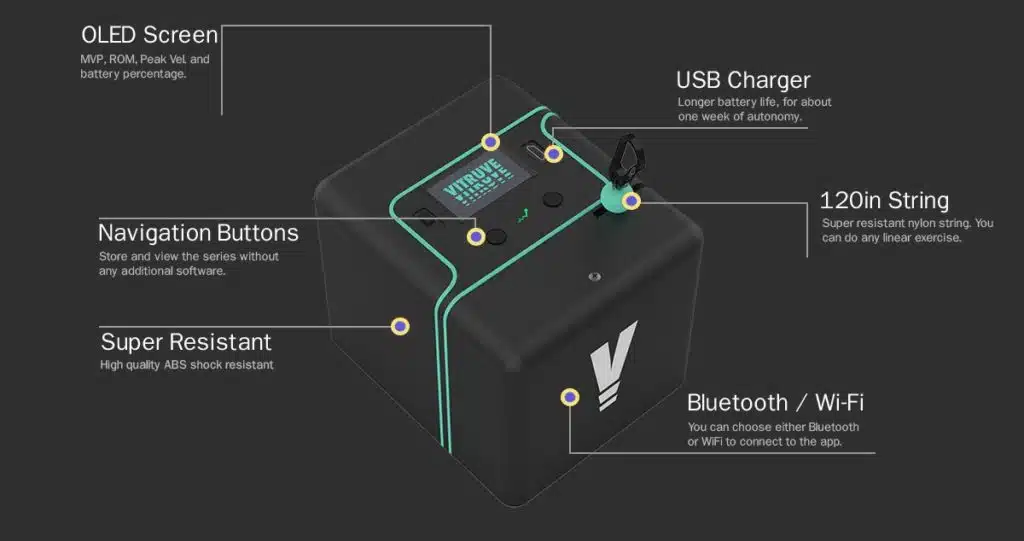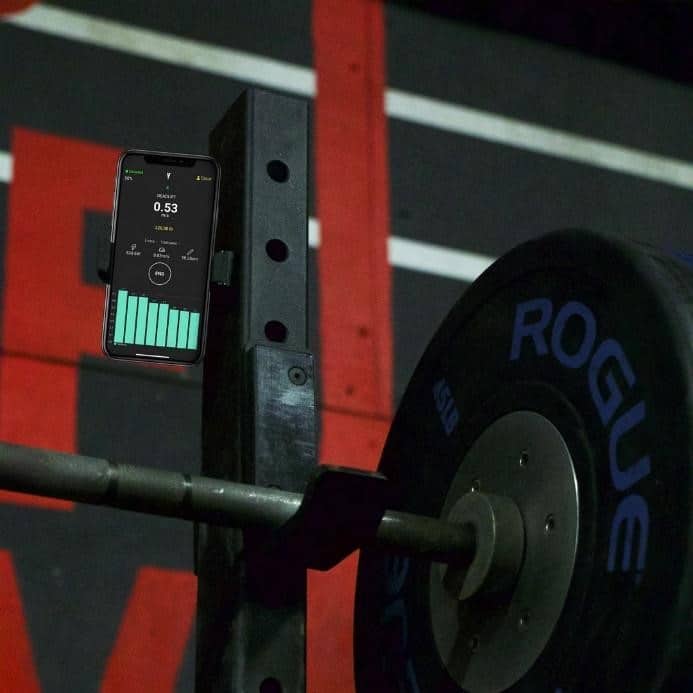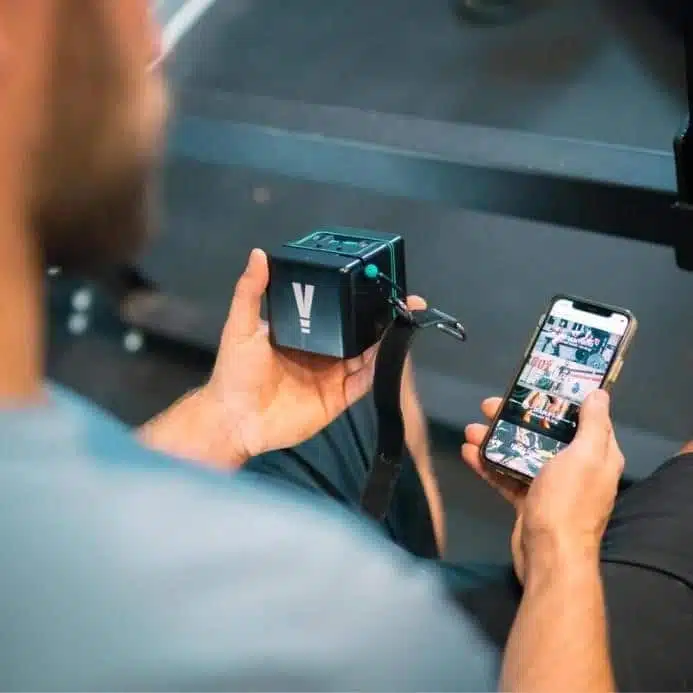14 de May de 2023
Barbell Velocity tracker for Strength Training
Barbell Velocity Tracker – What’s its Purpose?
A Barbell Velocity Tracker connects directly or indirectly to the bar and calculates how far it has moved and how long it has taken to move. The use of barbell speed trackers is growing exponentially in recent years (Gonzalez-Badillo et al., 2022). The use of bar speed trackers by all types of strength and conditioning coaches and athletes is being added to the weight rooms of elite teams, Bryan Mann is the researcher who coined the term ‘velocity-based training‘ (VBT). In that line of research, publications by authors such as Gonzalez Badillo who have been domesticating the use of barbell velocity trackers with their findings have skyrocketed (Gonzalez-Badillo et al., 2017; Jimenez-Reyes et al., 2021).
Add to this increasingly versatile bar velocity trackers for a much lower price than those used as the gold standard, and we have the perfect mix to benefit from the use of these devices in a very favorable way. There is now equipment on the market that is as simple to use as hooking a string to the bar and training as we normally do, with the difference that we obtain vital variables to monitor the fatigue of the session and the progress of the training program.
Available Metrics Analyzed by The Vitruve Barbell Velocity tracker
Each bar speed tracker provides more or less performance parameters. Vitruve’s Bar Velocity Tracker yields the following metrics to analyze and adjust each workout:
- Mean Propulsive Velocity (MPV): is the average velocity from the beginning of the concentric phase until the bar acceleration is less than gravity.
- Mean Velocity (MV): is the average value of the total velocities in a sum of time. That is, it is the average of the sum of all instantaneous velocities in a lift.
- Fatigue: within speed-based training, fatigue is measured through the loss of speed both between sets and within sets.
- Between-set fatigue: between-set fatigue refers to the loss of speed from the fastest set repetition of the entire workout to the slowest set repetition.
- Intra-set fatigue refers to the loss of speed that occurs within a single set, from the first repetition, or the fastest repetition (in some cases not the first) to the slowest repetition.
- Peak velocity: the peak velocity is a specific point in the movement where the velocity of the measured object (center of mass, weight, projectile…) is at its maximum. Depending on the type of motion being performed, the peak velocity will occur in different regions within the motion.
- Range of motion: the distance or path that we make with the load, in one of its phases (concentric or eccentric), either with a barbell, a dumbbell, or whatever the object to be moved, of whatever type.
- Average Power: is the average value of the power applied during a lift.
- Peak Power: is the value of power that is achieved by applying the highest degree of force at a given time.
- Peak Force: the maximum force that an athlete can express regardless of his body weight.

Every Barbell Velocity Tracker is Different
When performing measurements in a laboratory, gold standards are used, which are expensive and difficult to transport, but very accurate in their measurements (Weakley, Mann, et al., 2021). It is essential that such technology measures what we want to measure (it is valid) and that it reproduces the measurements on separate occasions without fluctuation between them (it is reliable). If validity or reliability fails, there will be a measurement error and the data obtained cannot be considered.
Due to various drawbacks of the gold-standard rod velocity trackers, such as 3D optoelectronic three-dimensional motion capture, alternative equipment such as the Vitruve rod velocity tracker has emerged. There are many others on the market, some with scientific evidence supporting their validity and reliability and others that do not. The Vitruve rod velocity tracker has extensive scientific literature showing that its data are just as valid and reliable as those yielded by a laboratory gold standard (Callaghan et al., 2022; Perez-Castilla et al., 2019; Weakley, Morrison, et al., 2021).
Which Devices can Track Bar Speed?

The most widely marketed rod velocity trackers are arranged into three groups primarily: linear velocity transducers, accelerometers, and optical laser devices (Weakley, Morrison, et al., 2021). The difference between them is the way they measure bar velocity and the metrics they capture. Linear transducers, of which the Vitruve bar velocity tracker is one, have been shown to be the most accurate and precise in the scientific literature, demonstrating that it is as valid and reliable as a gold standard, but with many more advantages (Weakley, Morrison, et al., 2021).
In a previous article in our blog we extensively detailed which are the most marketed bar velocity trackers and the scientific evidence behind them. It is very important that when choosing one device or another you consider such validity and reliability, in addition to the manageability of the product and that data analysis is simple, both for an individual athlete and for a large team. Vitruve’s barbell speed tracker is very intuitive and syncs with your cell phone or tablet so you can manage it and analyze the data very easily.
How to Measure Bar Speed With a Barbell Tracker?
Strength training based on speed is a complement that marks a before and after when it comes to training. To carry it out, you only need to use a bar speed tracker, but the exercises and sessions are carried out as normal. To measure the speed of the bar, connect it with the Vitruve encoder through the thread and hook that incorporates, and you only have to perform the exercises as you have been doing. The difference is that now the device will show you the speed at which you move the bar, in addition to the metrics described above.
The data can be viewed both on the Vitruve device and on a screen synchronized with it, for which you simply have to download the free application with which it will connect. Once you have the application on your mobile or tablet synchronized with the Vitruve device, and the equipment attached to the bar, you will see in real time in each repetition different parameters such as power, bar speed, range of motion … If you do not know the benefits of strength training based on speed, you may think why you need to know these parameters. In the following section we indicate why the use of bar speed trackers, more than recommended, is almost mandatory if we want to maximize athletic performance.
Vitruve Bar Velocity Tracker – Features & Benefits

Vitruve’s speed tracker is the tool that allows you to reach your maximum performance in strength training. As we have already mentioned above, it is one of the most valid and reliable sports linear encoders on the market, to which is added its manageability and ease of having data in real time and analyzing it afterwards. A fundamental detail in the use of bar speed trackers is that you must always move the load as fast as you can. If you do not take this into account, the lift will not be valid. Always move the load as fast as possible, whatever the load is, so that the data obtained can be considered and have no errors.
You are a Different Athlete Every Day
What is your 1RM, are you sure? Heraclitus wisely said that “no one can bathe twice in the same river,” alluding to the fact that neither the water in the river is the same nor the person. Nothing remains the same, and neither does our maximum daily lift. Our lifestyle positively and negatively affects our performance. In a few days we cannot physiologically go from moving a maximum of 100 kilos in bench press to moving 120 kilos, but if we have not slept well, we have a high level of stress and we are also fatigued, there can be variability of that type in our loads.
Surely one day you have found yourself very strong as you were warming up and you have moved the loads more easily than just a few days before. Conversely, it is also very likely that you have noticed how the kilos that you handled “easily” that day weigh you much more. That is the reason why the calculation of 1RM should be done daily, although that is infeasible to do in the traditional way, so it is done every so often and trained for months with the data obtained from the tests (Zhang et al., 2022).
A barbell speed tracker gives us each day our actual 1RM, which may vary very little or a lot with other days. If that 1RM starts to grow each week, we are training very well, and progress is measurable. If that 1RM begins to decrease chronically, we are facing the urgent need to introduce one or two weeks of unloading because the athlete is entering a phase of overtraining. Something so important for athletic performance can be calculated in one or two lifts in the warm-up, thanks to a bar speed tracker. To do this we will use a high load that we know we are not going to fail, but that is the same for a while.
- If that same load moves slower, our 1RM drops. In that situation, if it happens occasionally, and the decrease is not very large, we will train based on that 1RM.
- If that same load moves faster, our 1RM goes up. In that situation we will adapt the loads of the day to that 1RM, since we are stronger, and we will be able to move more kilos.
Adapt Your Training Sessions to Your Sport
The Vitruve barbell velocity tracker allows us to calculate what is the strength-velocity profile with a test in which we increase the loads. As the load is higher, the velocity will be lower, which forms a line that corresponds to our strength-velocity profile (Jiménez-Reyes et al., 2021). This individual profile can be compared with the strength-velocity profile of our sport, even of our position if it is a team sport since the needs vary based on the place and functions we have on the field. This could not be done without bar speed trackers.
Fatigue and progress
The traditional training method prescribes a closed number of sets and reps, with no difference between athletes. The external load is the same for everyone, but the internal load will be very different. One athlete may receive a perceived effort of 9 out of 10 with a session, while another, with the same intensity and volume, may feel that the effort has been 7 out of 10. The Vitruve speed tracker allows us to individualize the external load of each athlete based on the internal load.
To do this we will consider the loss of speed that occurs within the series and between series. You can program the Vitruve application to alert you when you lose a certain percentage of speed. The greater the loss of speed, the greater the fatigue in the session and the longer the recovery time until the next session (González-Badillo et al., 2017; Pareja-Blanco et al., 2020). In this way, all your athletes will have the same loss of speed, and that will cause one athlete to do more or less sets and repetitions than another, but the stimulus for both will be the same. In short, the barbell speed tracker will make all your athletes progress, not as it happens with the traditional method in which some improve, others stay the same, and others even get worse with training.

Velocity Based Training 【 #1 VBT Guide in the World 】
More Motivation – Less Injuries
If you have not yet trained with a barbell speed tracker, you might be surprised at the increase in motivation this technology produces in you and the athletes. By seeing our lifting speed on each repetition, the athlete becomes motivated and strives to keep that speed as high as possible, and not decline between repetitions (Weakley et al., 2020). That causes workouts to be more efficient and each repetition to be squeezed to the max (Thompson et al., 2022).
Of course, all the benefits of using a barbell speed tracker like Vitruve’s are linked to a lower risk of injury (Suchomel et al., 2021). Based on the speed of the lift, we know at every moment if the athlete is fatigued, if they can train harder or if they should rest. You can use this technology in your warm-up and ask each athlete to do a vertical jump (Cooper et al., 2020; Watkins et al., 2017). If an athlete loses considerable takeoff speed and height on the jump, modify their training because they are fatigued. If we don’t have a bar speed tracker, we won’t be able to monitor something as simple as that, and not giving rest can lead to injury.
Joaquín Vico Plaza
Bibliographical References
Callaghan, D. E., Guy, J. H., Elsworthy, N., & Kean, C. (2022). Validity of the PUSH band 2.0 and Speed4lifts to measure velocity during upper and lower body free-weight resistance exercises. Https://Doi.Org/10.1080/02640414.2022.2043629, 40(9), 968–975. https://doi.org/10.1080/02640414.2022.2043629
Cooper, C. N., Dabbs, N. C., Davis, J., & Sauls, N. M. (2020). Effects of Lower-Body Muscular Fatigue on Vertical Jump and Balance Performance. Journal of Strength and Conditioning Research, 34(10), 2903–2910. https://doi.org/10.1519/JSC.0000000000002882
González-Badillo, J. J., Sánchez-Medina, L., Ribas-Serna, J., & Rodríguez-Rosell, D. (2022). Toward a New Paradigm in Resistance Training by Means of Velocity Monitoring: A Critical and Challenging Narrative. Sports Medicine – Open, 8(1). https://doi.org/10.1186/S40798-022-00513-Z
González-Badillo, J. J., Yañez-García, J. M., Mora-Custodio, R., & Rodríguez-Rosell, D. (2017). Velocity Loss as a Variable for Monitoring Resistance Exercise. International Journal of Sports Medicine, 38(3), 217–225. https://doi.org/10.1055/S-0042-120324
Jiménez-Reyes, P., Castaño-Zambudio, A., Cuadrado-Peñafiel, V., González-Hernández, J. M., Capelo-Ramírez, F., Martínez-Aranda, L. M., & González-Badillo, J. J. (2021). Differences between adjusted vs. non-adjusted loads in velocity-based training: consequences for strength training control and programming. PeerJ, 9. https://doi.org/10.7717/PEERJ.10942
Pareja-Blanco, F., Alcazar, J., Sánchez-Valdepeñas, J., Cornejo-Daza, P. J., Piqueras-Sanchiz, F., Mora-Vela, R., Sánchez-Moreno, M., Bachero-Mena, B., Ortega-Becerra, M., & Alegre, L. M. (2020). Velocity Loss as a Critical Variable Determining the Adaptations to Strength Training. Medicine and Science in Sports and Exercise, 52(8), 1752–1762. https://doi.org/10.1249/MSS.0000000000002295
Pérez-Castilla, A., Piepoli, A., Delgado-García, G., Garrido-Blanca, G., & García-Ramos, A. (2019). Reliability and Concurrent Validity of Seven Commercially Available Devices for the Assessment of Movement Velocity at Different Intensities During the Bench Press. Journal of Strength and Conditioning Research, 33(5), 1258–1265. https://doi.org/10.1519/JSC.0000000000003118
Suchomel, T. J., Nimphius, S., Bellon, C. R., Hornsby, W. G., & Stone, M. H. (2021). Training for Muscular Strength: Methods for Monitoring and Adjusting Training Intensity. Sports Medicine (Auckland, N.Z.), 51(10), 2051–2066. https://doi.org/10.1007/S40279-021-01488-9
Thompson, S. W., Olusoga, P., Rogerson, D., Ruddock, A., & Barnes, A. (2022). “Is it a slow day or a go day?”: The perceptions and applications of velocity-based training within elite strength and conditioning. International Journal of Sports Science and Coaching. https://doi.org/10.1177/17479541221099641/ASSET/IMAGES/LARGE/10.1177_17479541221099641-FIG3.JPEG
Watkins, C. M., Barillas, S. R., Wong, M. A., Archer, D. C., Dobbs, I. J., Lockie, R. G., Coburn, J. W., Tran, T. T., & Brown, L. E. (2017). Determination of Vertical Jump as a Measure of Neuromuscular Readiness and Fatigue. Journal of Strength and Conditioning Research, 31(12), 3305–3310. https://doi.org/10.1519/JSC.0000000000002231
Weakley, J., Mann, B., Banyard, H., McLaren, S., Scott, T., & Garcia-Ramos, A. (2021). Velocity-based training: From theory to application. Strength and Conditioning Journal, 43(2), 31–49. https://doi.org/10.1519/SSC.0000000000000560
Weakley, J., Morrison, M., García-Ramos, A., Johnston, R., James, L., & Cole, M. H. (2021). The Validity and Reliability of Commercially Available Resistance Training Monitoring Devices: A Systematic Review. Sports Medicine (Auckland, N.Z.), 51(3), 443–502. https://doi.org/10.1007/S40279-020-01382-W
Weakley, J., Wilson, K., Till, K., Banyard, H., Dyson, J., Phibbs, P., Read, D., & Jones, B. (2020). Show Me, Tell Me, Encourage Me: The Effect of Different Forms of Feedback on Resistance Training Performance. Journal of Strength and Conditioning Research, 34(11), 3157–3163. https://doi.org/10.1519/JSC.0000000000002887
Zhang, X., Feng, S., Peng, R., & Li, H. (2022). The Role of Velocity-Based Training (VBT) in Enhancing Athletic Performance in Trained Individuals: A Meta-Analysis of Controlled Trials. International Journal of Environmental Research and Public Health, 19(15). https://doi.org/10.3390/IJERPH19159252/S1

